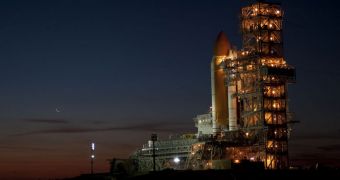The space shuttle Discovery appears to be plagued by bad luck. After all it's been through since late October, the orbiter underwent two new check-ups on the night of February 8 and the morning of February 9. A tool used to repair the spacecraft came loose and fell to the ground at the launch pad.
The accident took place as engineering teams at the Kennedy Space Center (KSC), in Florida, were repairing yet another leaky valve at the Launch Pad 39A facility. This is where Discovery is due to launch from on February 24.
As workers were taking care of their business – replacing a hydrogen vent valve that failed a recent test – a feeler gauge came apart from its rest, and fall from a top catwalk above the shuttle down to the ground. NASA reports that no one was wounded in the incident.
A feeler gauge is a measuring instrument made up of 13 bladed of steel of varied thicknesses. Each of them has a marking on the side showing how thick it is, and engineers usually use such devices to measure clearances between parts and other tiny distances.
The one that fell from the Launch Pad 39A catwalk did not open, and did not hit anyone on its way down. What it did though was raise the alarm yet again for experts seeking to repair Discovery in time for its February launch.
They looked for signs of any potential damage on the walls of the external fuel tank, the two solid rocket boosters (SRB) and the shuttle itself the night of February 8, but they couldn't find anything wrong with it.
Team repeated the search early the next morning with the same result. No visible damage is immediately visible on any component of the flight system, Space reports.
Regardless, engineers will “look at exactly every inch of the orbiter and the external tank to make sure it's safe and good to go for the February 24 launch," NASA spokeswoman Candrea Thompson explains.
The shuttle was originally scheduled to take off in early November 2010, but a large variety of issues, glitches and malfunctions prevented it from launching. Eventually, engineers found that its external fuel tank had a very large number of cracks on it.
After rolling the spacecraft back to the Vehicle Assembly Building (VAB) in late December, NASA experts repaired the EFT thoroughly, and then rolled Discovery back out. The orbiter is now ready to take off for the International Space Station.
It will carry a Multipurpose Logistics Module (MPLM) and a robotic astronaut, which was developed by NASA and General Motors. The STS-133 mission is to be Discovery's last, before finally being retired and put on display at the Smithsonian Air and Space Museum, in Washington.

 14 DAY TRIAL //
14 DAY TRIAL //